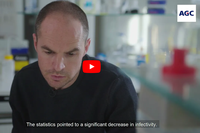NARILIS collaboration with AGC and Public Hospitals of Paris reveals the potential of coated glass to mitigate the spread of SARS-CoV-2
The most important mode of transmission for SARS-CoV-2 occurs through close contact from person-to-person, via respiratory droplets and aerosols. But it may also be possible to get contaminated indirectly through the environment, as the virus can persist for hours on surfaces or objects.
In response to the COVID-19 outbreak, the European leader in flat glass AGC Glass Europe (Louvain-la-Neuve, Belgium) raised the question about SARS-CoV-2 stability on glass and the potential of coatings to reduce viral lifespan. To address this question, the team of Prof. Benoît Muylkens (UNamur, Integrated Veterinary Research Unit - URVI) analyzed the decay rate of SARS-CoV-2 infectivity in a laboratory setting. The experimental work was conducted by PhD student Laura Bonil and postdoc researcher Dr. Damien Coupeau. The researchers deposited SARS-CoV-2 in the form of small droplets on different non-porous materials such as classic glass, acrylic glass, photo-activated TiO2 coated glass, aluminium and stainless steel. Thanks to a fruitful collaboration with virologists and biostatisticians of the Public Hospitals of Paris, a critical analysis of the findings could be generated. Overall, the statistical analysis demonstrated that viral infectivity decreased more rapidly in contact with coated glass produced by AGC, compared with non-coated glass. Such innovative material may therefore offer a practical and feasible solution to decrease the risk of SARS-CoV-2 transmission in high-traffic areas such as public places, transport or buildings. The results of this successful collaboration have just been published in the journal “Coatings” (Bonil et al., 2021).
Watch also the video produced by AGC on the genesis of the project, the concept, its findings and outcomes.
 NAmur Research Institute for LIfe Sciences
NAmur Research Institute for LIfe Sciences


